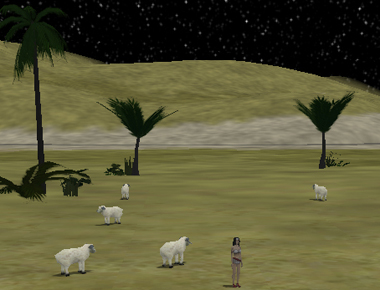Wild Sheep
In the wild, flocks of sheep appear at random, standing in grassy areas. Clicking on a wild sheep will give you the option to either pick it up, or attempt to slaughter it. Wild sheep will always allow themselves to be picked up, but will usually run away if you try to slaughter them. Successfully slaughtering a wild sheep will add 6 mutton, 2 leather, and 10 oil to your inventory.
New immigrants will almost certainly find it easier to trade for a breeding pair, rather than searching for wild sheep.
- 2005/07/02 Announcing the new Sheepdar!!!! Show me the Sheepdar!!
I have seen wild sheep 4 times and every time it has been during the day and in a populated area. I found 2 females right on the path in LN in the middle of the day. I then needed a male so I ran around grassy areas in the middle of nowhere for an entire night and found no sheep. I eventually got a male from a friend. Since then, 3 different times they have spawned right by my compound in DoS. Probably still easier to trade for a pair, but keep in mind they don't always spawn at night. -Rubenette
I do a lot of running through grassy areas, foraging, and I have run into sheep a lot. For me, they have appeard in the afternoon and late night near water. Below is a image of sheep sighting, all male sheep in Northern Cradle of the Sun. -Trillian
Domesticated Sheep
Note: Soloers and casual players should think carefully before beginning to raise sheep in large quantities. Sheep can eat a lot of onions, and can quickly turn into a full-time job. Sheep products are usually inexpensive, and it may be easier to trade for what one needs than to produce it, depending on what you find fun. See offline chores for a way to grow onions offline - this will support a single sheep pen with relative ease.
Sheep kept in a sheep pen, which may be built in a compound or outside with a small construction site (which must be built on a grassy area for the purpose of "grazing").
Sheep in a pen eat onions and produce dung. They eat every 3 hours, with a male sheep eating 3 onions at a time and a female sheep eating 1 onion at a time. At the same time, 1 dung is produced for every three sheep. When slaughtered a sheep yields 6 mutton, 2 leather, and 10 oil. All sheep products remain in the pen until removed.
Sheep can be transferred between the pen and your inventory using the "Herd" option.
Every breeding cycle, which occurs when the sheep eat, there is a possibility that each breeding pair of sheep in a pen will produce a new sheep. Sheep do not stud -- if there are three females and one male in a pen, at most one lamb will be born in the next breeding cycle. Sheep will never breed to produce more than 10 sheep in a pen.
When first placed in a pen, sheep often take a while to begin breeding (possibly several days). Speculation is that adding to/taking from the herd prevents breeding until the newcomers settle in. Since sheep breeding is random, it is difficult to measure this period exactly.
The optimal number of sheep per pen to maximize population growth is three males and three females.
The optimal number of sheep per pen to maximize dung production is any multiple of 3 females. Every three hours they will eat 3x onions and produce 1x dung. For example: I currently have a pen with 114 female sheep which produces 38 dung every 3 hours (assuming it has onions).
It is possible to separate the males from the females in a pen, to prevent further breeding.
Your sheep will slowly start dying off one by one if not fed for about 24-48 RL hours. This was true in T1, but the starvation code was accidentally switched off (and left off when discovered) in T2 - sheep do not starve.
You may also examine your sheep, and will either see "look fine" (all ok, but not breeding?) or "feel frisky and healthy" (actively available for breeding). The message, "The sheep seem to be searching around for food. Perhaps they would enjoy some tasty onions?", indicateds the sheep are going hungry. There may also be another message for the sheep starving/dying.
Sheep Pox
In the past, our ancestors suffered outbreaks of Sheep Pox in their herds. In modern times, however, this disease has been eradicated.
